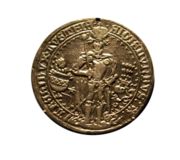
Guldengroschen
Encyclopedia

Silver
Silver is a metallic chemical element with the chemical symbol Ag and atomic number 47. A soft, white, lustrous transition metal, it has the highest electrical conductivity of any element and the highest thermal conductivity of any metal...
coin
Coin
A coin is a piece of hard material that is standardized in weight, is produced in large quantities in order to facilitate trade, and primarily can be used as a legal tender token for commerce in the designated country, region, or territory....
originally minted in Tirol
German Tyrol
German Tyrol is a historical region in the Alps now divided between Austria and Italy. It includes largely ethnic German areas of historical County of Tyrol: the Austrian state of Tyrol and the province of South Tyrol but not the largely Italian-speaking province of Trentino .-History:German...
in 1486.
The Guldengroschen's name comes from the fact that it has an equivalent denomination value in silver relative to that of the goldgulden (60 kreuzer
Kreuzer
The Kreuzer, in English usually kreutzer, was a silver coin and unit of currency existing in the southern German states prior to the unification of Germany, and in Austria.-Early history:...
). In the latter years of the 1470s and early years of the 1480s Sigismund of Austria issued decrees that reformed the poor state of his region's coinage by improving the silver fineness back to a level not seen in centuries (.937 pure) and created denominations larger than the ubiquitous, but fairly low valued Groschen
Groschen
Groschen was the name for a coin used in various German-speaking states as well as some non-German-speaking countries of Central Europe , the Danubian principalities...
of 4 to 6 Kreuzer
Kreuzer
The Kreuzer, in English usually kreutzer, was a silver coin and unit of currency existing in the southern German states prior to the unification of Germany, and in Austria.-Early history:...
that were in use.
In 1484, small numbers of "half guldengroschens" valued at 30 kreuzer were issued. This was a revolutionary leap in denomination from the smaller pieces, and surpassed even the large testones of Italy
Italy
Italy , officially the Italian Republic languages]] under the European Charter for Regional or Minority Languages. In each of these, Italy's official name is as follows:;;;;;;;;), is a unitary parliamentary republic in South-Central Europe. To the north it borders France, Switzerland, Austria and...
which were the highest weight coins in use. Finally in 1486 the full sized guldengroschen of 60 kreuzers was put into circulation and it was soon nicknamed "guldiner". For a long time thereafter such coins were also called "unciales" because their actual silver weight was very nearly one ounce
Ounce
The ounce is a unit of mass with several definitions, the most commonly used of which are equal to approximately 28 grams. The ounce is used in a number of different systems, including various systems of mass that form part of the imperial and United States customary systems...
. As large quantities of silver became available other states began issuing guldiners of their own. Bern, in modern day Switzerland was one of the earliest to follow Tirol by issuing its guldiners in 1493. In 1500, Saxony's mint at Annaberg took minting of guldiners to new heights and the economies of central Europe welcomed these large new coins.

Cologne mark
The Cologne Mark was a unit of weight equivalent to 233.856 grams. It was introduced by the Danish King Hans in the late 15th century and was used as a standard for weighing metals...
. The penultimate development of the guldiner occurred in 1518 when the Joachimsthal mint in Habsburg
Habsburg
The House of Habsburg , also found as Hapsburg, and also known as House of Austria is one of the most important royal houses of Europe and is best known for being an origin of all of the formally elected Holy Roman Emperors between 1438 and 1740, as well as rulers of the Austrian Empire and...
-controlled Bohemia
Bohemia
Bohemia is a historical region in central Europe, occupying the western two-thirds of the traditional Czech Lands. It is located in the contemporary Czech Republic with its capital in Prague...
slightly altered the weight of the coin from 31.93 g down to 29.20 g. This made it possible to mint nine guldiners to have the silver weight equivalent of one Cologne Mark, rather than the eight in Tirol. This new coin was known as the Joachimsthaler (Joachimsthal guldiner), but like the guldengroschen being contracted to guldiner, the joachimsthaler became known simply as the thaler
Thaler
The Thaler was a silver coin used throughout Europe for almost four hundred years. Its name lives on in various currencies as the dollar or tolar. Etymologically, "Thaler" is an abbreviation of "Joachimsthaler", a coin type from the city of Joachimsthal in Bohemia, where some of the first such...
. This new coin was an instant success and was the great grandfather of many other similar weight coins like the daalder, dollar
Dollar
The dollar is the name of the official currency of many countries, including Australia, Belize, Canada, Ecuador, El Salvador, Hong Kong, New Zealand, Singapore, Taiwan, and the United States.-Etymology:...
, tolar
Tolar
Tolar is the Czech name for the silver coin mined in Bohemia in 16th century in Údolí Svatého Jáchyma . The modern word dollar was derived from the Spanish dollars, so called in the English speaking world because they were of similar size, and weight to the German Thalers...
, tallero, etc.


